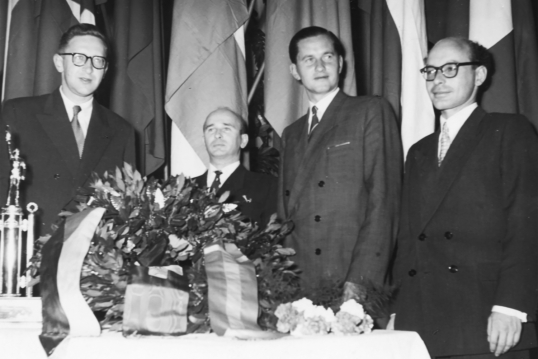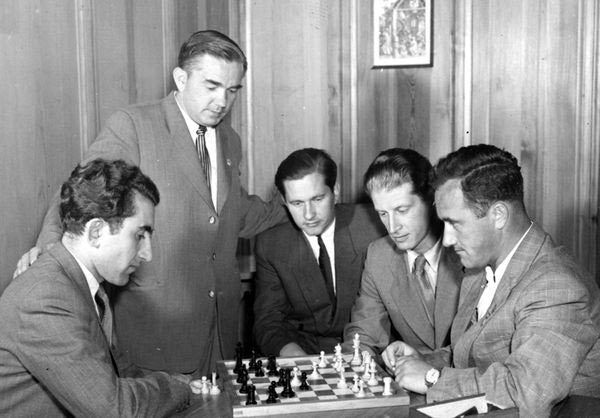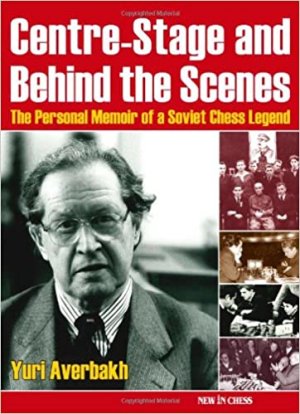


ChessBase 17 - Mega package - Edition 2024
It is the program of choice for anyone who loves the game and wants to know more about it. Start your personal success story with ChessBase and enjoy the game even more.
This is part 2 of the series (see part 1)
In chess you win some and you lose some. But how do you explain that to your parents, who do not want you to play this game where “everything” depends on luck? Young Yuri and his parents had survived the misery and privation of the Second World War. Yuri was a bright student and qualified to become an engineer. But in their eyes chess was always in the way of his career. He didn’t have much co-operation from the Engineering Institute either for his chess activity.
Master Class Vol.13 - Tigran Petrosian
Considered a master of prophylaxis, Petrosian sensed dangers long before they actually became acute on the board. In his prime, Petrosian was almost invincible. Let our authors introduce you into the world of Tigran Petrosian.
By sheer dint of effort he qualified for the Interzonal and thereafter won a place in the Candidates’ Tournament in Zürich. 70 years later, that legendary contest held in 1953 is still remembered. Among others, it included Smyslov, Keres, Bronstein, Boleslavsky and Petrosian. The challenge from the West came from Euwe, Reshevsky and Najdorf.

Vasily Smyslov, Samuel Resshevsky, Paul Keres and David Bronstein, Candidates’ Tournament, Zürich 1953 | Photo: ChessPro
And what about Yuri? He was 31 and found the going tough. He lost to Reshevsky, Taimanov, Kotov, Gligoric and Stahlberg (now that is a long list!). Kotov took him down with a queen sacrifice followed by a king hunt. Stahlberg always had his “number”. Here he lost to him twice. However, he managed to beat Keres, Taimanov, Najdorf and Euwe.
What happened in the game with Keres? In his haste to mount an attack on the black king, the Estonian overlooked a counterintuitive move by Yuri. His attempt to recover the ground thereafter turned out to be unsuccessful on account of alert play by our protagonist.
This game cost Keres a valuable point and he fell behind in the race for the first place, which was finally won by Smyslov.
In the second game here, Yuri meets a dangerous TN (theoretical novelty) from the former world champion and succeeds with cool play.
To return to Averbakh’s narrative in this book, he does not find excuses for his failure in this tournament. He did not have a grandmaster coach to work with him and train him. So only his friend Mikhail Beilin helped him. Before the tournament, he studied the games of his prospective opponents from chess magazines and was troubled by self-doubt. Was this preparation enough? As it turned out, it was not. His opponents had greater knowledge and experience.
In the end he finished with less than 50% (+5, - 6, =17).

Tigran Petrosian, Alexader Kotov, Paul Keres, Yuri Averbakh and Efim Geller analysing | Photo: ChessWood.ru
In his account of the tournament, Averbakh mentions how seriously the Soviets had taken this tournament. The team had nine players, nine trainers, a doctor and an interpreter, in addition to the Head of the Delegation and his deputy (from KGB).
Their stay in Zürich was not without “adventures”. Here is the first as narrated by Averbakh:
When we had to move to Zürich, the delegation leader, Postnikov, went ahead with Kotov, and the interpreter, I. Zaitsev, to find a suitable hotel and book rooms. Thus we ended up at the Hotel Goldenes Schwert, in a small street in old Zürich. No sooner had we arrived there that the owner, a fat Italian gentleman, took Postnikov aside and said in a whisper, “I see, you have a few young chaps. Tell them, they are not allowed to bring in more than two women at night!”
You can imagine for yourself what our boss went through in these conditions…It turned out that our hotel was in the heart of the red light district of Zürich, and it was virtually a bordello! Naturally, our morally upright leader could not put up with this, and after a week we moved to a quieter area.
The second adventure was more serious, and it could have spelt trouble for Averbakh.
Once, when Beilin (Averbakh’s second) and I returned from a round, the receptionist gave us the keys to the room and also a packet of sweets. Someone had sent it to us. In the room we opened the packet. It did indeed contain sweets, but that was not all. Underneath was a printed proclamation of the NTS (National Labor Union of Russian Solidarity, an organization that was opposed to the Soviet regime). “Chess players!”, it read, “Are you aware of Stalin’s crimes, and of the millions of people in labour camps?” Much of what was written in the proclamation was unknown to us. The 20th Congress, at which Khrushchev exposed the crimes of Stalin was still two years* away.
We read the proclamation and ate the sweets. It became clear that the same present had been sent to all members of our delegation. We decided to take the package of proclamations to the leaders of our delegation to demonstrate our loyalty. The deputy leader of the delegation (of course, from the KGB) heard us out and then seeing the empty packet sternly asked:
“Where are the sweets?”
“We ate them.”
“You did what?”, he pounced on us. “They might have been poisoned!”
“I risked trying one of them,” said Beilin. “It tasted fine. Then Averbakh joined me.”
But that is not the whole story. As Sergey Voronkov points out, Averbakh carefully omits what happened before.
 It’s probable that Averbakh knew about what was being sent to them in advance! Before the war, young Yuri was friends with Evgeny Romanov (then Ostrovsky), the future leader of the NTS, and later happened to see him abroad. The first time was at the Stockholm Interzonal (1952). As he reminisced later:
It’s probable that Averbakh knew about what was being sent to them in advance! Before the war, young Yuri was friends with Evgeny Romanov (then Ostrovsky), the future leader of the NTS, and later happened to see him abroad. The first time was at the Stockholm Interzonal (1952). As he reminisced later:
I still remember, I was playing a game in one of the rounds at the Interzonal. I happened to raise my eyes, and who do I see? It’s Ostrovsky standing at the table! When I told my mother about our meeting, she burned all the letters from Zhenya that I had... The next year he came to see the Candidates’ Tournament in Zürich. We talked again a couple of times, although it was not safe. Is it a joke, communicating with the leader of the NTS?
What was their conversation about? One does not know. Voronkov comments, it’s unlikely that Romanov would have set up Averbakh without his knowledge.
[Pictured: Evgeny Romanov in later years | Photo: ntsrs.ru]
To be continued
 1) One limitation of this book is that there are no games in it. From this point of view, his other work, Averbakh’s Selected Games (Cadogan, 1998), deserves mention. However, I have found Big DataBase also useful, as it has many of the games mentioned by Averbakh in this book.
1) One limitation of this book is that there are no games in it. From this point of view, his other work, Averbakh’s Selected Games (Cadogan, 1998), deserves mention. However, I have found Big DataBase also useful, as it has many of the games mentioned by Averbakh in this book.
2) * As Steve Giddins, the translator, points out in the book, it was more like three years away. The Congress took place in 1956 and Khruschev’s speech was given to a closed session on the final day.
3) The story of Averbakh’s encounters with his old friend Evgeny Romanov (Ostrobvsky) appears in an article by Sergey Voronkov on ChessPro.ru.: https://chesspro.ru/enciklopediya/v-ozhidanii-ottepeli
Here is a Google Translate version for English readers: https://rb.gy/awkwcl
3) As an organization, the NTS (Наро́дно-трудово́й сою́з росси́йских солидаристов) did put up a heroic resistance against Stalinism, but it was doomed to failure. Many of its members were arrested and shot or sent to labour camps. Subsequently, its surviving members carried their campaign abroad. The organization still maintains its presence: http://ntsrs.ru/
Master Class Vol.14 - Vasily Smyslov
Smyslov cultivated a clear positional style and even in sharp tactical positions often relied more on his intuition than on concrete calculation of variations. Let our authors introduce you into the world of Vasily Smyslov.
| Advertising |